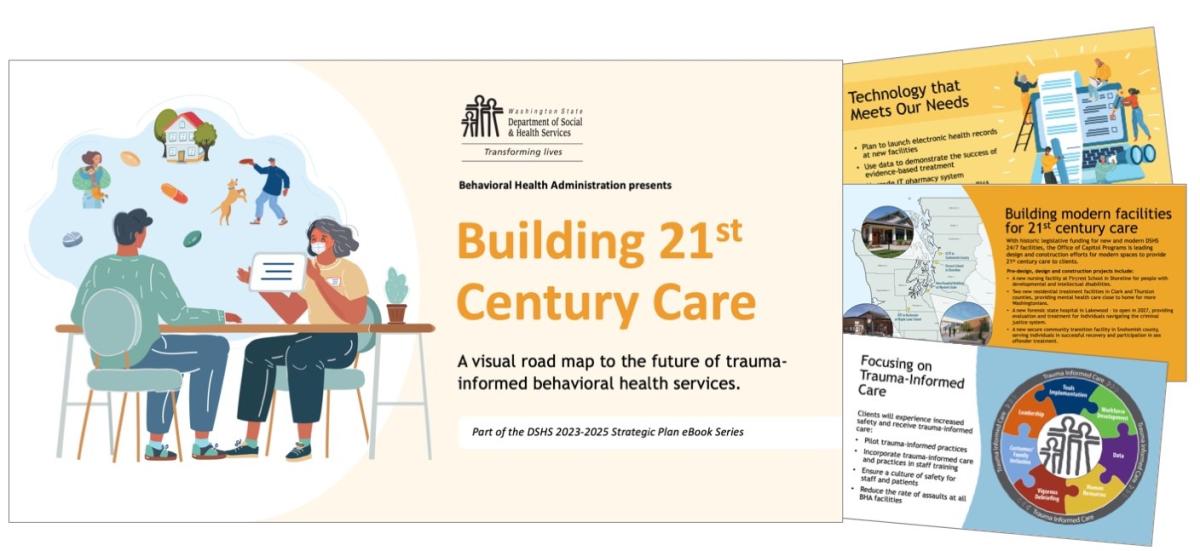Changes to the BHA Strategic Plan
Since BHA’s strategic plan is a dynamic document, we make periodic changes to it. As success measures transition from long-term visions to becoming embedded in our daily operations, they are removed from the strategic plan. Questions about these changes can be sent to bhacommunications@dshs.wa.gov.
 |
Building 21st Century CareA guide to Behavioral Health Administration's strategic plan for the 2023-2025 planning cycle. |
|---|
From breaking ground on modern care facilities to focusing on trauma-informed care, the future of 21st Century behavioral health care in Washington state is bright.
 |
Read and download BHA's 2023-2025 Strategic eBook here> |
|---|
BHA's 2023 - 2025 Strategic Plan
BHA's 2023 - 2025 Strategic Plan
In the strategic planning process, we identify three key components.
- The Strategic Objective: Sets the goal that we are striving to achieve.
- The Action Plan: Our action steps to get there.
- The Success Measure: The outcome that would let us know we have achieved that goal by 2025.
Read in detail below about all of the components of BHA's strategic plan. To read about BHA's Strategic Plan Metrics, read the full report here.
Strategic plan index: Jump to a section of the plan by clicking the Strategic Objective (SO)
- Strategic Objective 1: Better prepare patients to successfully transition back to their communities.
- Strategic Objective 2: Promote a culture of safety for staff and patients.
- Strategic Objective 3: Reduce the demand for and provide timely civil and forensic services for behavioral health patients.
- Strategic Objective 4: Provide culturally appropriate services and programming for Native American patients within BHA facilities.
- Strategic Objective 5: Standardize and upgrade IT resources and processes across BHA and our facilities in alignment with DSHS enterprise IT strategies.
- Strategic Objective 6: Advance a culture that weaves equity, diversity, access and inclusion into the fabric of leadership, processes and employee development.
- Strategic Objective 7: Continue our efforts to be an employer of choice – recruiting and retaining individuals committed to a career in public service.
Strategic Objective 1: Better prepare patients to successfully transition back to their communities.
Success Measure 1.1: By July 2025, BHA facilities will increase the rate of treatment hours provided per patient days by 10%.
Action Plan Items:
ESH & WSH:
A. By July 2025, implement treatment programming for individuals with sexually problematic behavior and/or sex offense histories.
B. Increase BHA and community programming options for patients. Increase staffing and supports as needed to take patients to community programming.
C. Establish a vocational rehab workgroup to design a vocational rehab program and process. Draft a proposal and funding request to provide these services within BHA facilities. "
Strategic Objective 2: Promote a culture of safety for staff and patients.
Success Measure 2.1: Decrease the rate of staff assaults and severe assault-related patient injuries by 10% from FY2023 to FY2025.
Action Plan Items:
OFMHS, SCC, WSH, CCBH:
A. Incorporate trauma-informed care practices into operations and crisis response situations.
ALL BHA Facilities:
B. Enhance and expand training for all staff on safety practices and interventions.
C. Analyze data including from workplace violence prevention program and the violence risk assessment to determine core causes of violence with the goal of providing support, enhancing and expanding training, and/or developing additional early intervention strategies.
D. Conduct post-incident reviews and incorporate findings into policy, procedures, and training as appropriate."
Success Measure 2.2: Reduce the use of patient seclusion and patient restraint by 10% from FY2023 to FY2025.
Action Plan Items:
ESH & WSH:
A. Reduce patient agitation through use of low-stimulation areas.
B. Complete post-seclusion/restraint debriefings.
Strategic Objective 3: Reduce the demand for and provide timely civil and forensic services for behavioral health patients.
Success Measure 3.1: Increase the number of yearly participants in state-funded Prosecutorial Diversion Programs by 10% from FY2023 to FY2025.
Action Plan Items:
OFMHS:
A. Identify additional sites where successful Prosecutorial Diversion Programs could be launched in alignment with settlement agreement requirements and request funding to implement.
Success Measure 3.2: Decrease the time from court order to admission for inpatient competency restoration to 14 days by July 2025.
Action Plan Items:
OFMHS:
A. Conduct a periodic review to identify patients who can be transitioned to a less acute level of care.
B. Divert misdemeanor and specific level C felonies.
C. Refer second and third 90-day orders to the existing Outpatient Competency Restoration Programs to free up space at the RTFs and state hospitals for clients waiting in jail.
Success Measure 3.3: Increase the number of jail- based evaluations completed within 14 days to 95% in FY2025.
Action Plan Items:
OFMHS:
A. Fully implement new additions to the RCW 10.77 and budget which includes: diversion program for nonfelony and C level felonies, placing clinical intervention specialists in jail, expansion of staff who meet developmental disability professional criteria, the evaluator support team, and other measures that will hopefully decrease the amount of competency evaluation referrals which allows for an increase in evaluations completed within the 14 days.
B. Identify local and systemic challenges in the evaluation process through increases in data monitoring and analysis and proactively responding to challenges through outreach, process changes and other appropriate measures.
C. Develop a robust re-evaluation process to identify individuals who have regained competency.
Strategic Objective 4: Provide culturally appropriate services and programming for Native American patients within BHA facilities.
Success Measure 4.1: Offer contracted cultural services to 100% of Native American patients within each BHA facility by July 2025
Action Plan Items:
ALL & Tribal Affairs:
A. Create workgroups within each BHA facility by July 2024 to navigate the contracting process.
B. Collaborate with BHA employees to coordinate tribal services and programs within each facility.
C. Develop a BHA sweat lodge policy and procedures plan.
D. If resources allow, hire a BHA Tribal Affairs advocate to work with Native American patients within BHA facilities.
Strategic Objective 5: Standardize and upgrade IT resources and processes across BHA and our facilities in alignment with DSHS enterprise IT strategies.
Success Measure 5.1: Develop a standard IT Enterprise Support Model and Software Development life cycle by July 2025.
Action Plan Items:
ALL & IT:
A. Move from federated to enterprise support model.
B. Staff and align resources to meet BHA IT needs.
C. Develop standard processes, procedures and policies for IT practice.
D. Execute EHR readiness workgroups at ESH and WSH associated with the MultiCare contract.
Strategic Objective 6: Advance a culture that weaves equity, diversity, access and inclusion into the fabric of leadership, processes and employee development.
Success Measure 6.1: By July 2025, increase the number of EDAI educational events and opportunities offered at BHA facilities by 20%.
Action Plan Items:
ALL & EDAI:
A. BHA CoP to create EDAI toolkit for supervisors and managers to have facilitated conversations with staff that include EDAI topics.
B. BHA CoP to create or acquire EDAI educational events and opportunities for BHA facilities and teams to put on or attend. Incorporate CDE/CDPs as champions to support this work.
C. Create a tool to follow-up with CDE/CDPs to better understand how certified professionals are incorporating what they learned into their daily work, teams, programs, and facilities.
D. Establish a full-time position in each BHA facility that is allocated to serve as a subject matter expert in equity, diversity, access and inclusion by July 2025.
E. Review Employee Engagement Survey questionnaires that reference EDAI and identify baseline scores throughout BHA that pertain to belonging and acceptance.
Strategic Objective 7: Continue our efforts to be an employer of choice – recruiting and retaining individuals committed to a career in public service.
Success Measure 7.1: Increase BHA’s exit survey participation rate from 6% to 15% by July 2025.
Action Plan Items:
ALL:
A. Establish a workgroup to
review the current exit survey process.
B. Identify program staff who will support the HR process.
C. Establish a collection process and provide paper copies of surveys to floor staff without a designated work station.
Success Measure 7.2: BHA will implement an administration-wide stay interview process by June 2024, and 25% of BHA staff will have a stay interview by July 2025.
Action Plan Items:
ALL:
A. Review the existing DSHS stay interview process.
B. Develop communication plan to inform supervisors of the stay interview process.
C. Develop method of collecting high level data from stay interview process following HR guidelines.
